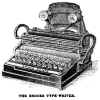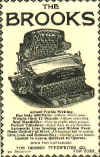Early Office Museum
Other Antique Type-Bar Typewriters
This gallery covers early keyboard type-bar machines that do not appear to
have been used widely in U.S. offices, judging from early photographs of office
interiors. However, U.S. ads for Bar-Lock, Williams and Wellington typewriters claimed that
these type writers were used in government or corporate offices, and Bar-Locks
were used in offices in England, as a photograph below demonstrates..
|

Bar-Lock No. 1

Bar-Lock No. 2

Salter Improved No. 5

Salter No. 10
Photo shows position of the type-bars on downstrike machines
|
Downstrike Typewriters
~ Bar-Lock ~ Franklin ~ Salter ~
 The type-bars on downstrike typewriters are
arranged in a nearly vertical semicircle
between the keyboard and carriage, and they strike downward. The
illustration to the right shows the key and type-bar movement for the
Franklin Typewriter. The Franklin evolved through several
models between 1891 and 1906, with total production of about 20,000
typewriters. (ETCetera, Issue 1, Oct. 1987) The type-bars on downstrike typewriters are
arranged in a nearly vertical semicircle
between the keyboard and carriage, and they strike downward. The
illustration to the right shows the key and type-bar movement for the
Franklin Typewriter. The Franklin evolved through several
models between 1891 and 1906, with total production of about 20,000
typewriters. (ETCetera, Issue 1, Oct. 1987)
Downstrike
machines were advertised as visible typewriters. However, to view
what had been typed, the typist had to stand or lean over the machine in
order to see past the wall of type-bars.
The
Bar-Lock Typewriter,
which had a double keyboard, was introduced in 1889. The
name of the machine refers to a mechanism that locked the type-bars in position
while they printed.
 In 1896, the Bar-Lock type writer's name in the U.S. was changed to Columbia Bar-Lock.
During 1896-99, U.S. ads claimed that the machine was
widely used in offices and by the Navy. See illustration to the right. In 1896, the Bar-Lock type writer's name in the U.S. was changed to Columbia Bar-Lock.
During 1896-99, U.S. ads claimed that the machine was
widely used in offices and by the Navy. See illustration to the right. The
machine was sold as the Royal Bar-Lock in Great Britain. A c. 1898 English ad
for the Royal Bar-Lock stated that the machine had "fifty
thousand users." The ad stated that over 200 of the machines were
being used by Lever Brothers Ltd., over 60 in total by the London,
Glasgow, and Liverpool municipal governments combined, over 40 by the
London and Lancashire Fire Insurance Co., and over 30 each by the
Secretary's Department of the General Post Office, by Arthur Guinness,
Sons & Co., by the Eastern and Associated Telegraph Cos., and by the
English offices of the Mutual Life Insurance Co. of New York.
In 1899, an ad claimed that the Sunlight Soap Co. was using over 160 Royal
Bar-Locks. In
1901, an ad claimed that 150 Royal Bar-Locks were used in post offices in the
UK. E. H. Beach, Tools of Business, 1905, states that the
British royal palaces used five  times as many Bar-Locks as all other makes
combined, that the three largest British city governments (London,
Glasgow, and Liverpool) used eight times as many Bar-Locks as all other
makes combined, and that the three largest companies (The Bank of England,
the Eastern Telegraph Co., and Messrs. Dever Brothers, Ltd.) used nine
times as many Bar-Locks as all other makes combined. Beach also
states that the British war office and admiralty used over 400
Bar-Locks. The photo to the right shows a number of Bar-Locks in an English
office. times as many Bar-Locks as all other makes
combined, that the three largest British city governments (London,
Glasgow, and Liverpool) used eight times as many Bar-Locks as all other
makes combined, and that the three largest companies (The Bank of England,
the Eastern Telegraph Co., and Messrs. Dever Brothers, Ltd.) used nine
times as many Bar-Locks as all other makes combined. Beach also
states that the British war office and admiralty used over 400
Bar-Locks. The photo to the right shows a number of Bar-Locks in an English
office.
 Other downstrike typewriters were the Horton Typewriter
(1886) and
Salter Typewriter (1892). The earlier
of the two Horton models weighs 19 lb. The 1892 Franklin weighs 11.5 lb. Other downstrike typewriters were the Horton Typewriter
(1886) and
Salter Typewriter (1892). The earlier
of the two Horton models weighs 19 lb. The 1892 Franklin weighs 11.5 lb.
|

Illustration from Bar-Lock Ad with the caption "View as Seen When
Writing." However, this view is directly down on the machine.

New Franklin, 1890s

New Franklin, 1890s, showing ribbon spools were positioned above
the platen
|
|

Williams No. 1. Notice that only two lines of
type are visible.

Williams No. 2, 1897
|
Typewriters with
Grasshopper Movements
~ Williams ~
On the Williams Typewriter (1891), half the
type-bars are located in a semicircle
fanning out in front of the platen and half are in a similar semicircle
behind the platen. The type-bars hop or leap toward the platen, striking
from above, as the photograph to the right demonstrates.
The Williams type-heads rest on ink pads, so there is no ribbon.
When a fresh sheet of paper is put in the typewriter, it is rolled into the
paper basket formed by metal bands under the type-bars in front of the
platen. (See images to the left.) As the typing proceeds, the paper
rolls over the platen into the paper basket behind the platen. The machine
was advertised with the claim "visible writing," but the
operator was able to read only two lines without turning the
platen.
A 1896 Williams advertisement claimed the company had sold 25 typewriters
to the US Agricultural Department, and an 1897 advertisement claimed the company had
sold 200 typewriters to "one large house." An 1898 ad claimed that "22 of Uncle
Sam's Warships have been supplied with Williams Typewriters." Another machine with a grasshopper movement is the
Maskelyne
Typewriter (1890s). All its type-bars are located in front of the platen. |

Williams No. 2, 1897

Maskelyne Typewriter
|
|

Rapid, 1891 ad

Empire

Ford, 1896 ad
|
Typewriters with Thrust
Movements
~ Wellington/Empire ~ Ford ~
On a thrust machine, the type-bars dart forward and strike the platen
from the front, like ram rods, without a swinging or hopping motion.
Examples of thrust typewriters are the Rapid
Typewriter (1888), Wellington Typewriter (1892), Ford Typewriter
(1895), and Granville Automatic Typewriter (1896). The Wellington
was sold in Canada and Europe under the Empire
Typewriter name,
and also in Europe under the Adler Typewriter name. The Ford Typewriter was the first typewriter to use aluminum. However, it did not work well and failed commercially.
The principal selling point of thrust action typewriters was that they
were relatively quiet. Adler (p. 83) observes that thrust action typewriters did not perform
well in cutting duplicating stencils, a fact that presumably limited their
use in offices. However, the Wellington seems eventually to have resolved
this problem. An 1898 ad claimed that over 60 Wellington
machines were used by Canadian Pacific Railways, and a 1900 Wellington ad claimed that this $60 machine "has
taken the place of $100 machines in some of the largest
corporations."
|

Empire with top removed to reveal type-bars

Ford detail
|
|

North's Typewriter
|
Backstrike Typewriters
~ North's ~ Brooks ~
On four short-lived machines, the Fitch Typewriter (1888), Waverly
Typewriter (1889), Brooks Typewriter (1891), and North’s
Typewriter (1892),
the type-bars were positioned overlooking the carriage from
behind, in contrast to downstrike machines, on which the type-bars
overlooked the carriage from the front. The backstrike design was
intended to make work more visible to the operator. To keep the paper out
of the way of the type-bars, the paper moved from a basket in front of the
platen to another basket behind the platen, as on a Williams typewriter.
Because of this arrangement, the operator could see only a couple of lines
of typing without rewinding the platen. The Fitch, Waverly, and Brooks weigh 11 lb.,
18.5 lb., and 17 lb., respectively.
|

Brooks Typewriter, 1891

Brooks Typewriter, 1895
|
|
Original Prices for Downstrike,
Grasshopper, Thrust, and Backstrike Typewriters
With the exception of the Bar-Lock and
Williams, these typewriters were sold at prices lower than those on the
standard upstrike typewriters of the day.
| Typewriter |
Year |
Price |
| . |
Downstrike |
. |
Bar-Lock No. 2
No. 3 (wide carriage) |
1891
1891
|
$100
$110
|
Franklin
Franklin
No. 7
No. 9
|
1892-93
1893-96, 1901-03
1908
1904-06 |
$60
$75
$75
$75 |
|
Grasshopper |
|
| Williams No. 1, 2, 4 |
1908 |
$95 |
| . |
Thrust |
. |
| Rapid |
c. 1890 |
$70 |
Ford (iron)
Ford (aluminum) |
1895-96
1895-96 |
$75
$85 |
| Wellington & Wellington
No. 2 |
1897-1901, 1906 |
$60 |
|
Backstrike |
|
| Fitch |
c. 1890 |
$50 |
|
Darryl Rehr, Antique Typewriters, 1997, refers to the
"Brooks Typewriter of 1895." 1895 was the date of the first
patent award to Brooks for this type of typewriter. An earlier version of
the Brooks Typewriter existed by 1891; it is pictured in Appleton's Annual
Cyclopaedia 1890, 1891, p. 812.
Return to Top of this Page
|











